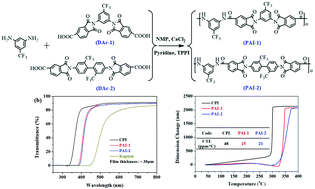Reduced coefficient of linear thermal expansion for colorless and transparent polyimide by introducing rigid-rod amide units: synthesis and properties†
Abstract
Optically transparent polyimide (PI) films with high-temperature resistance have been considered as promising flexible substrate materials for next-generation micro-electronics fields. However, the trade-off between high optical transparency and a low coefficient of linear thermal expansion (CTE) in one material is the key issue to realize their applications. In this work, an effective design to solve the problem is presented by introducing rigid-rod amide units in colorless and transparent PI chains to regulate intra- and interchain interactions. Based on this concept, two types of highly transparent poly(amide-imide) (PAI) films with low CTE were synthesized derived from 3,5-diaminobenzotrifluoride (m-TFPDA) and novel diacids containing imide rings 2,2′-(5-(trifluoromethyl)-1,3-phenylene)bis(1,3-dioxoisoindoline-5-carboxylic acid) (DAc-1) and 2,2′-(2,2′-bis(trifluoromethyl)-[1,1′-biphenyl]-4,4′-diyl)bis(1,3-dioxoisoindoline-5-carboxylic acid) (DAc-2), respectively. The obtained PAI films (approximately 30 μm) achieved high optical transparency (λcutoff = 380 nm, T450 nm = 81%, haze = 0.80), light color (L* = 95.42, a* = −1.45, b* = 5.04, yellow index = 7.23), and low CTE = 15 parts per million per °C. The PAI films also exhibited satisfactory thermal stability with a glass transition temperature (Tgs) at approximately 320 °C and 5 wt% decomposition temperature (Td 5%) above 450 °C under an N2 atmosphere. The tensile strength and modulus exceeded 100 MPa and 2.50 GPa, respectively. The intrinsic dielectric constant (k) and dielectric loss values are approximately 2.60 and 0.02 at 10 kHz, respectively, and a stable low-dielectric performance was observed up to 280 °C. This design strategy successfully lowers the CTE and maintains high optical transparency of PI films due to the rigid-rod amide unit increasing the rigidity of the molecular backbones, enhancing the orientation of in-plane polymer chains, and controlling the charge transfer complex (CTC) effects, which was proved by aggregation structure analysis and simulated calculations. This design strategy can also be used in other structures to prepare highly transparent PI films with low CTE for flexible micro-electronics fields.



 Please wait while we load your content...
Please wait while we load your content...